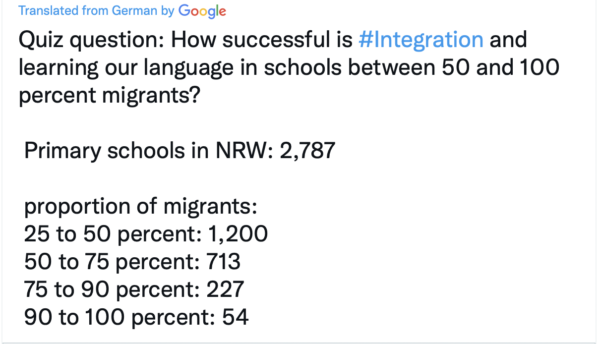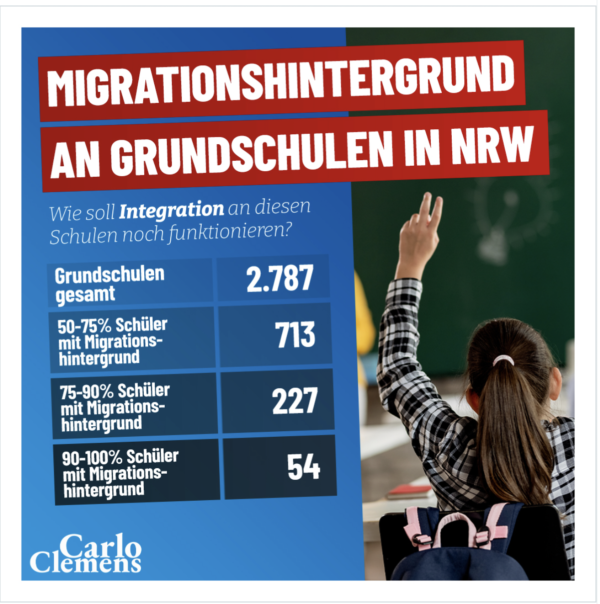GERMANY: Nearly 1,000 elementary schools in a single region of the country have a majority of students with a Muslim migration background
Children with a Muslim migrant background from Africa and the Middle East now make up the majority of students in just under 1,000 schools in a single region of Germany, a considerable proportion of all the schools there, official statistics have revealed.

Breitbart (h/t Nita) According to a post by state Bundestag MP Carlo Clemens reflecting on official government statistics, of North-Rhine Westphalia’s 2,787 primary schools, students with a migrant background make up a majority of students in 994 of them.
“Anyone who still speaks of “integration” as a solution to mass immigration wants to deceive,” Clemens wrote on social media while commenting on the statistics.



This is a a considerable proportion of all the schools there, official statistics have revealed. The data emerges as the country’s federal authorities angle for increased mass Muslim migration into the country in the hopes of alleviating staff shortages experienced by businesses in the wake of COVID-19. (Considering that at least half of them will live on welfare forever, not a good idea)
The Muslim migrant wave was sold to Germans by telling them that the migrants would replace the aging workforce and do jobs there weren’t any more Germans to do. The reality is that most migrants came and didn’t get jobs at all, but went on welfare. Germany: 66% of migrants on welfare, 5.6% of native population on welfare.
“New data shows Germany’s 2015/16 migrant wave brought few skilled workers,” by John Cody, ReMix News, May 30, 2022:
Of the more than 1 million migrants who came during the 2015/16 migrant wave to Germany, almost 900,000 of them still live on Hartz IV, which is the country’s social benefit system.
According to Germany’s Federal Employment Agency, only 460,000 of the Syrians, Afghans, Somalis, Iraqis, and other Middle Eastern and African migrants who arrived in Germany in 2015/16 are employed, and more than half of those are in unskilled jobs.
In addition, 670,000 migrants are either unemployed or looking for work, with 235,000 unemployed and 437,000 looking for work. From both groups, 88 percent have no professional qualifications.
“If the current demographic developments continue, it will be the children without a migration background who will have to integrate,” he went on to claim.
Over One in Four People in Germany Have a ‘Migrant Background’https://t.co/vGX6i7vor5
— Breitbart London (@BreitbartLondon) April 14, 2022
While the future is always unpredictable, based on current rhetoric coming from officials in the country, these trends do indeed look likely to continue, with ministers in Germany’s federal government actively angling to bring in more migrants.
For example, the ostensibly right-leaning Freie Demokratische Partei, or Free Democratic Party (FDP) — really a globalist, pro-business party — has been pushing for more migrants to be brought into Germany “immediately”, with the party’s parliamentary leader saying that such an influx would solve the country’s ongoing labour shortage, as well as to facilitate the retirement of the country’s baby-boomer generation
“The situation is dramatic and because that’s the case, we need immigration,” parliamentary leader Christian Dürr argued, who said that anyone who can work should be let in. “After all, he pays taxes and pays into the pension,” Dürr went on to say.
Even Amid Ongoing Energy Crisis, German Government Demands More Migrants ‘Immediately’ https://t.co/KZ5DnAS2RL
— Breitbart London (@BreitbartLondon) July 4, 2022

No comments:
Post a Comment